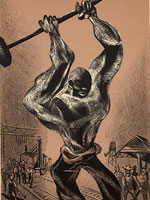Both are true, though neither is the whole story.
Industrialization and the factory system that helped launch it were both part of a larger shift in the American economy from an agricultural economy to one characterized by wage labor. In 1800, for example, three quarters of the nation's workforce was "agricultural"; by 1900, the industrial and service sectors accounted for two-thirds of the workforce. As wage labor supplanted agricultural labor, growing numbers of women entered the paid workforce while unpaid housework took on new cultural and economic significance.
In a very straightforward way, the industrial revolution prompted women to enter the paid workforce. The textile industry provides a vivid illustration. The town of Lowell, MA, for example, was incorporated in 1826 and soon hosted over 30 different mills. Roughly three-quarters of their workers were women, who became nationally known as the "Lowell Mill Girls." In this the textile industry led a broader trend. Between 1850 and 1900, the percentage of all women aged 16 years or older employed in manufacturing industries—most of whom could be categorized as "working class"—ranged between 16 and 23 percent.
In addition to prompting many women to take paid work outside the home, the industrial revolution changed the cultural and economic value of unpaid "housework.
In addition to prompting many women to take paid work outside the home, the industrial revolution changed the cultural and economic value of unpaid "housework." Although much of the actual work that women performed in the "domestic sphere" remained the same across the 19th century—cooking, cleaning, caring for children, maintaining family social relationships, and otherwise managing the household economy—culturally it lost much of its former value. As one historian has put it, the "gender division of labor" that once existed slowly became "a gendered definition of labor": men earned wages outside the home ("labor"), and women did unpaid work ("not labor") within it.
Yet this cultural devaluation of women's household work masked its continuing, deep-seated economic importance. Few working-class male wage-earners, for example, earned enough cash to meet all household economic needs, and relied on women's unpaid labor to make up the difference. In other words, working-class women's unpaid work was integral to the basic process of industrialization, providing a hidden "subsidy" to manufacturers that allowed them to pay less-than-subsistence wages to their employees. In this sense, both of the major types of work that women performed—paid and unpaid—were economically significant components of the industrial revolution in the United States.



